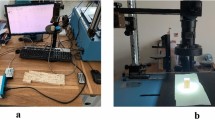Abstract
This paper presents a muitispectral system for evelution of linear algorithms for prediction of wood surface features important for automatic inspection of lumber. The selection of training samples, the imaging spectrograph scaning method, raw data representation, evaluation of linear algorithms and testing of performance is discussed. A possible on line implementation for high speed wood scanning with a smart sensor is outpointed. An example, showing the evolution of linear algorithms for prediction of compression wood in softwood species (Picea abies, Pinus sylvestris), is reported, showing verified 92–94% correct classification. It is shown that compression wood classification could be reduced to an uncomplicated linear model using just a few spectral components where the most important one is around the limit for visible light going to the Ultraviolet spectra. This almost univariate behaviour for the model is not the common behaviour for other wood surface features (Brunner et al., 1996; Hagman, 1995; Hagman, 1996).
Zusammenfassung
Diese Arbeit beschreibt ein Mehrkanalsystem zur Entwicklung eines linearen Algorithmus, der es gestattet, Eigenschaften von Holzoberflächen für eine automatische Gütesortierung von Schnittholz vorherzusagen. Die Auswahl von Testproben zum Kalibrieren des Systems, die Bilderzeugung durch Abrastern mit dem Bildspektrographen, die Darstellung der Rohdaten, die Beurteilung des linearen Algorithmus und die Eignung des Systems werden diskutiert. Die mögliche On-Line-Implementierung in ein Hochgeschwindigkeitsprüsystem für Schnittholz mit Hilfe eines schnellen Sensors wird aufgezeigt. Als Beispiel wird der lineare Algorithmus zur Vorhersage von Druckholzanteilen in Nadelholz (Picea abies, Pinus sylvestris) beschrieben, der eine 92–94% richtige Klassifizierung ermöglicht. Es konnte gezeigt werden, daß die Erkennung von Druckholz auf ein einfaches Modell reduziert werden kann, das nur wenige spektrale Komponenten erfordert, wobei die wichtigsten Wellenlängen im Bereich von der Grenze des sichtbaren Lichts bis zum UV-Bereich liegen. Dieses fast univariate Verhalten des Modells ist allerdings für die Bewertung anderer Oberflächeneigenschaften nicht der Fall.
Similar content being viewed by others
References
Astrand E, Osterberg M, Hagman, O Aström A (1995) Near. Sensor Real Time Spectral Time Classification for Industrial Applications. 9th Scandinavian Conference on Image Analysis. Uppsala. Sweden. 6–9 Jun.
Åström A (1993) Smart Image Sensors. Linköping Studies in Science and Technology. Dissertations. No. 319. pp. II 2–II 11
Brunner CC, Maristany AG, Butler DA, Funck JW (1993) Enhancing Color-image Data for Wood-Surface Feature Identification. Proc. 5th int. Conf. on Scanning Technology & process Control for the Wood Products Industry. 25.27 Oct. Atlanta, USA
Brunner CC, Maristani AG, Butler DA (1996) Wood species identification using spectral reflectance. Forest Prod. J. 46(2). pp. 82–85
Esbensen K, Geladi P, Grahn HF (1992) Strategies for Multivariate image regression. Chemometrics and Intelligent Laboratory Systems. 14, pp 357–374
Grundberg S, Hagman O (1993) Measuring active wood fracture surfaces Holz Roh- Werkstoff 51, pp 49–54
Hagman POG (1993) Prediction of Wood Quality Features by Multivariate Models Based on Scanning Techniques. Thesis no. 20L. Luleå Technical University. Sweden
Hagman O, Grundberg S (1993) Multivariate Image Analysis Methods to Classify Features on Scots Pine: Evaluation of a Multisensor Approach. Proc. 5th int. Conf. on Scanning Technology & Process Control for the Wood Products Industry. 25.27 Oct. Atlanta, USA
Hagman O (1996) On Reflections of Wood —Wood Quality Features Modelled by Means of Multivariate Image Projections to Latent Structures in Multispectral Images Ph.D. thesis no 1996: 198 D. Luleå Technical University
Hyvärinen T (1993) Towards Rugged and Miniaturized NIR instruments Proc. The Second European Symposium on Near Infrared (NIR) Spectroscopy. 30 Aug-2 Sept, Kolding, Denmark
Lindgren F, Geladi P, Wold S (1993) The Kernel Algorithm for PLS. J. of Chemometrics. 7, pp 45–59
Martens H, Naes T (1989) Multivariate Calibration., pp 146–147. John Wiley & Sons, Inc., New York
Vogrig R, Karpp B, Portala JF, Adel M, Lefevre R (1993) Scanning for Optimized Lumber Ripping and Crosscutting. Proc. 5th int. Conf. on Scanning Technology & process Control for the Wood Products Industry. 25.27 Oct. Atlanta, USA
Author information
Authors and Affiliations
Corresponding author
Rights and permissions
About this article
Cite this article
Hagman, O. Multivariate prediction of wood surface features using an imaging spectrograph. Holz als Roh- und Werkstoff 55, 377–382 (1997). https://doi.org/10.1007/s001070050250
Issue Date:
DOI: https://doi.org/10.1007/s001070050250



